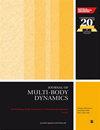Nonlinear tribodynamics of an elastic shaft with a flexible bearing outer race
IF 1.9
4区 工程技术
Q3 ENGINEERING, MECHANICAL
Proceedings of the Institution of Mechanical Engineers Part K-Journal of Multi-Body Dynamics
Pub Date : 2023-03-14
DOI:10.1177/14644193231161136
引用次数: 5
Abstract
In this paper, a mathematical model of a rotor-bearing system is presented. The model includes modal elastodynamics of a flexible rotor as well as the in-plane radial dynamics of the bearing with a flexible outer race. Elastodynamics of the flexible shaft utilises a solution based on Green's function to provide a computationally efficient approach. The flexible bearing outer race is modelled using Timoshenko beam theory. The system model also includes detailed lubricated contact mechanics of balls-to-races contacts with viscous friction. Therefore, the rotor-bearing analysis represents a detailed multi-physics tribodynamics and modal elastodynamic responses of the system which closely represents broad-band vibration response of such systems in practice, an approach not hitherto reported in the literature. It is also demonstrated that the outer race flexibility changes the location of the stability orbital centres, as well as the spread of limit cycle vibrations. Furthermore, it accentuates the occurrence of multiples of ball pass frequency. The importance of integrated system dynamics and lubricated contact mechanics is highlighted, showing that although the elastodynamic response of the rotor's flexible elements may not be clear in the acquired vibration signal, its effect on energy efficiency of the system can be quite important.具有柔性轴承外滚圈的弹性轴的非线性摩擦动力学
本文建立了转子-轴承系统的数学模型。该模型包括柔性转子的模态弹性动力学和具有柔性外圈的轴承的面内径向动力学。弹性轴的弹性动力学利用基于格林函数的解决方案,提供了一种计算效率高的方法。采用Timoshenko梁理论对柔性轴承外圈进行了建模。系统模型还包括详细的润滑接触力学的球与滚道接触的粘性摩擦。因此,转子-轴承分析代表了系统的详细的多物理场摩擦动力学和模态弹性动力学响应,它紧密地代表了实践中此类系统的宽带振动响应,这是迄今为止文献中尚未报道的方法。研究还表明,外圈柔性改变了稳定轨道中心的位置,也改变了极限环振动的传播。此外,它强调了球传递频率的倍数的发生。强调了集成系统动力学和润滑接触力学的重要性,表明尽管转子柔性元件的弹性动力学响应在获取的振动信号中可能不清晰,但其对系统能量效率的影响可能相当重要。
本文章由计算机程序翻译,如有差异,请以英文原文为准。
求助全文
约1分钟内获得全文
求助全文
来源期刊

CiteScore
4.10
自引率
11.10%
发文量
38
审稿时长
>12 weeks
期刊介绍:
The Journal of Multi-body Dynamics is a multi-disciplinary forum covering all aspects of mechanical design and dynamic analysis of multi-body systems. It is essential reading for academic and industrial research and development departments active in the mechanical design, monitoring and dynamic analysis of multi-body systems.
 求助内容:
求助内容: 应助结果提醒方式:
应助结果提醒方式:


